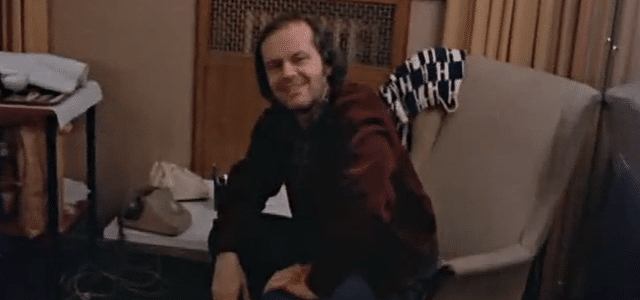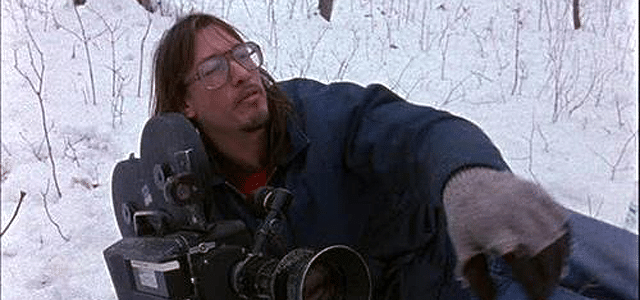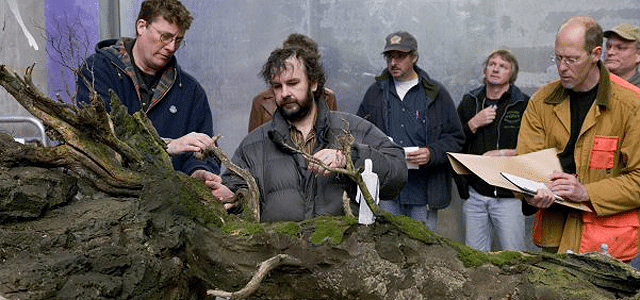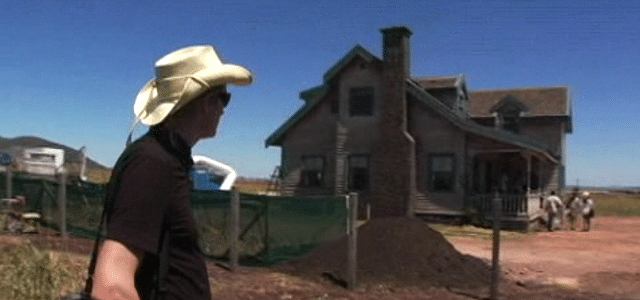8 Honest Behind-The-Scenes Documentaries That Show Both Sides Of Movie Making
by David Christopher Bell
It seems very rare that a behind-the-scenes documentary will earnestly try to show how the movie is made over trying to sensationalize the process. After all, who exactly is the demographic watching these things? Is it people who are genuinely interested in learning the techniques, or is it casual fans of a particular movie peeking behind the curtain?
A good documentary caters to both – but above all should be honest in how the film was made.
I’d like to explore some of the most earnest examples that I’ve come across. Either as stand alone films or DVD extras – these are documentaries that show, for better or for worse, the good and the bad aspects of the movie making process. This is stuff that no film goon should miss.
The Artistic Process
8. The Good: The Making of the Shining

Probably the most surreal behind-the-scenes look of any film, the reason why being how surprisingly in-depth it is for a film made before DVDs and special features. This is most likely because the lady behind the camera is none other than Vivian Kubrick, Stanley Kubrick’s daughter and someone you can’t just tell to screw off.
This is why we get to see Jack Nicholson casually brushing his teeth before taking a whiz in his dressing room, only to then light a smoke and walk blithely down stairs to chop a door down. It makes you wonder if they knew at the time just how big of a deal the film was going to be. It’s amazing to watch as Nicholson performs iconic scene after iconic scene, only to hear Kubrick indifferently call to check the gate and move on.
And that’s how it goes, all the talent and money centered on Stanley Kubrick – who sternly and quite literally calls all the shots as he adapts the classic horror book the way he feels like adapting it. We get to watch as he constantly re-writes on set, pushing his actors to be exactly what he wants them to be, even to the point of pushing them right over the edge – as we learn from Shelley Duvall, who becomes physically and mentally ill from the role.
7. The Bad: Our World, Their War – Transformers Special Edition
I’m not going to sit here all high and mighty and act like I didn’t love watching Transformers. Nor am I going to pretend like I don’t enjoy Michael Bay’s work. It’s great fun – however in terms of artistic integrity this film is not, as we’ve heard a million times, exactly Citizen Kane. But as the DVD extras of this film show – that’s no surprise to them.
Right from the start we get to hear Hasbro executives talking about making a movie that they can sell toys with – even working directly with Bay to design the characters to work specifically as products. That’s the whole damn point, right? We watch as Bay smiles while talking about the death threats he got from fans for screwing around with their childhood characters, how he made Optimus Prime mostly blue because “red doesn’t photograph well” and he clearly doesn’t care to try.
At one point before a giant bus stunt, while going over safety and procedure he just walks away exclaiming, “Fuck this, let’s go.” Because that’s the kind of guy he is. That’s why at one point they actually accidentally fling a car into the side of a building – because whatever. Let’s make an action movie and get paid.
In the end, there’s no denying the fun of it – even if it’s really just a 2-hour-long commercial for toys and cars with Bay at the center. In a weird way – he’s doing exactly what he should be.
Low-Budget Filmmaking
6. The Bad: American Movie

Whenever you hear the story of how some indie film got made, there’s inevitably a point in which the filmmaker had to take that big leap of faith. Kevin Smith maxed out credit cards, Robert Rodriguez sold his body to science – all in the trust that what they were doing was important. That they would make their film, and it would be go places.
American Movie showed us the depressingly hilarious flip side of that. It showed us that our passions are in fact capable of betraying us just as effectively as they can reward. It showed every aspiring filmmaker what exactly is at risk.
But you certainly can’t deny filmmaker Mark Borchardt’s passion any more than you can deny his alcoholism or impractical thinking. Still, that passion does go a long way, and you simply have to root for him as he struggles to make his terrible, terrible film. That’s why it’s nice to know that while the infamous Coven did not pan out like he hoped, he’s at least still making movie appearances to this day.
In fact – Borchardt has even gotten back on that directing horse with what looks to be his first feature length film, Scare Me, due to be out this year. I, for one, can’t wait.
5. The Good: Robert Rodriguez’s 10-Minute Film School
Continuing on the subject – independent filmmaking never fails to make the passion going into a project 100 times more visible due to the high quantities of blood and sweat put into it. You have to work creatively around your budget – and Robert Rodriguez figured out how to do exactly that. Now he wants us to do it as well – and shows us how with his little 10-Minute Film School bits on every movie DVD.
What’s great about it is how practical he makes the information, even when he is talking about a big budget film like Spy Kids or Sin City. He talks about how to backlight a shot so the CGI doesn’t have to be so well-defined later or how to use a location sparingly by shooting your establishing shots at a very high budget location and containing the rest elsewhere. The guy still thinks like an indie director despite working with big budget actors.
The best has to be El Mariachi’s lesson – where Rodriguez simply shows his raw footage, revealing just how deceptive his shooting style was as he edits in-camera to cheat the complications of an action sequence. Fingers as his slates, actors as his crew – he shows exactly what it means to make a high quality film at piss-poor prices.
Big-Budget Filmmaking
4. The Good: Peter Jackson’s King Kong Production Diaries

It’s really hard to swallow when a movie like Avatar manages to spend more money than God while somehow never leaving the studio to do it. Watching either Peter Jackson’s King Kong diaries or anything Lord Of The Rings, you actually get to see and understand where the money is going.
The diaries show us just how grand making a movie of this scale and detail is. There’s a whole diary devoted to finding and fixing up old cars to be used on the New York set and one just about the steam coming from the sewers. They show us the poor P. whose only job is to keep an eye out for passing airplanes that might ruin the shot. Let’s not forget the production designer who has to shape and create the various animal poop props for the Venture’s cargo area. So much colorful minutiae being carried out by so many people over days and days of production. We are reminded of just how many people need to be moved and fed and paid for this thing to come together.
King Kong was actually on the low side of what his films typically bring in (not that it wasn’t in the hundreds of millions), while costing almost twice as much as any one Lord Of The Ring film. At the time it was the most expensive movie ever – but Jackson knows how to spend that money. For him, the scope comes in the attention to crafted detail and not just trying to achieve some digital breakthrough or build the biggest set in the world. It’s about hiring artists to make art.
3. The Bad: Bryan Singer’s Superman Returns Production Diaries

King Kong and Superman Returns were both made in the same general area, had almost the exact same 200 million dollar budget, both had amazing production diaries, and were made so close together that they even share a diary episode at one point (and an amazing one at that!). The difference, however, was that Superman Returns made half of what King Kong did – all while making a lot of terrible budget decisions along the way.
For example, as Cracked.com pointed out – they spent 10 million on a space scene that never made it into the film, as well as built Kent Farm totally from scratch, going so far as to grow the actual corn, despite it having a very limited screen time. It’s not like we’re talking about the Fortress Of Solitude here, just cornfields and barns. Go to Kentucky guys, it’s cheaper.
I should say that personally speaking – I actually love this film. I love Bryan Singer’s attitude as a director and I love watching these productions diaries. That said, it seems like I am in the minority here, nor can I deny that they could have focused their budget way better than they did. In the end, despite all that money and planning, the story simply wasn’t good enough.
The Entire Production
2. The Bad: Hearts Of Darkness: A Filmmaker’s Apocalypse
“We were in the jungle. There were too many of us. We had access to too much money. Too much equipment. And little by little we went insane.” – Francis Ford Coppola
Apocalypse Now is a lot like “Fear and Loathing in Las Vegas” in that it was guided into success by such blind luck that you could never repeat the results. It’s why every English student who downs a bottle of rum in front of his or her typewriter in some silly hope to be the next Hunter S. Thompson only has a bad liver to show for it.
Everything that could go wrong went wrong here, from the sets, which were trashed by a typhoon halfway through production, to the actors, who spent the days in a drug-fueled stupor.
Harvey Keitel – the original lead – was replaced with Martin Sheen who then had a breakdown on the set. The environment of the Philippines was inherently unstable as helicopters kept leaving the shots to conduct actual wars. Marlon Brando’s ego demanded a million dollars without any guarantee that he’d actually show up – and when he did he was a mess.
Point is – this is not how to make a movie. Don’t go across the globe with a half-written script and millions of dollars expecting to make one of the best films ever made. 99.9999% of the time you’ll just end up shooting yourself – something that Coppola apparently did consider as a viable plan B.
Still – it seems like the most surreal aspect of this whole documentary is the fact that George Lucas was originally supposed to direct it.
1. The Good: Full-Tilt Boogie – The Making Of From Dusk Till Dawn
If you had to just watch one of items on this list – this is the one. While it certainly isn’t the most exciting divulgence into movie making, that’s exactly why it’s the most honest. It shows, without filter, exactly what it’s like to work on a film set.
The film follows everything from the monster effects and makeup to George Clooney’s assistant making mundane errands, the director of photography setting up shots to the paparazzi parked miles from the set. Literally every aspect of what goes into a film is featured – things like craft services and grip department get their slice. We see the drunken after parties of the day and the hotel noise complaints. Birthday parties, staff contests, all of the bullshit you see in any job – just slightly more surreal.
All of it opened with one of the silliest staged bits ever as George Clooney and Quentin Tarantino “get lost” while looking for the set, stopping only to cast aside nerdy fans holding Pulp Fiction posters and ER headshots – that is, of course, with the exception of one attractive female fan who they ever-so-graciously stop for.







